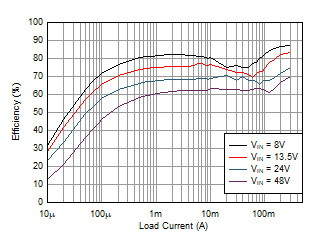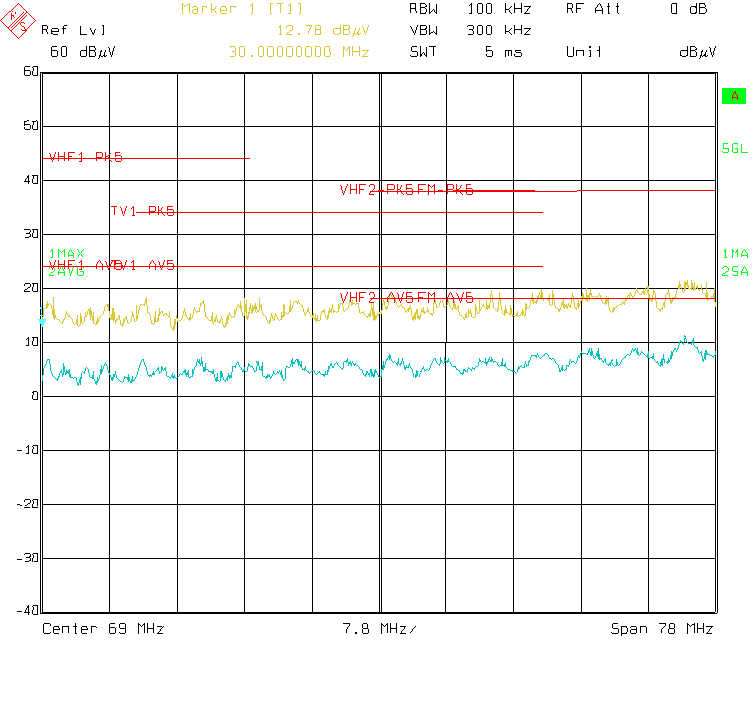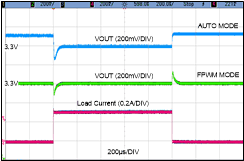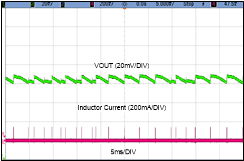SNVSBB5B September 2019 – September 2020 LMR36503-Q1
PRODUCTION DATA
- 1 Features
- 2 Applications
- 3 Description
- 4 Revision History
- 5 Device Comparison Table
- 6 Pin Configuration and Functions
- 7 Specifications
-
8 Detailed Description
- 8.1 Overview
- 8.2 Functional Block Diagram
- 8.3
Feature Description
- 8.3.1 Enable, Start-up and Shutdown
- 8.3.2 External CLK SYNC (with MODE/SYNC)
- 8.3.3 Adjustable Switching Frequency (with RT)
- 8.3.4 Power-Good Output Operation
- 8.3.5 Internal LDO, VCC UVLO, and VOUT/BIAS Input
- 8.3.6 Bootstrap Voltage and VCBOOT-UVLO (CBOOT Terminal)
- 8.3.7 Output Voltage Selection
- 8.3.8 Soft Start and Recovery from Dropout
- 8.3.9 Current Limit and Short Circuit
- 8.3.10 Thermal Shutdown
- 8.3.11 Input Supply Current
- 8.4 Device Functional Modes
-
9 Application and Implementation
- 9.1 Application Information
- 9.2
Typical Application
- 9.2.1 Design Requirements
- 9.2.2 Detailed Design Procedure
- 9.2.3 Application Curves
- 9.3 What to Do and What Not to Do
- 10Power Supply Recommendations
- 11Layout
- 12Device and Documentation Support
- 13Mechanical, Packaging, and Orderable Information
Package Options
Mechanical Data (Package|Pins)
- RPE|9
Thermal pad, mechanical data (Package|Pins)
- RPE|9
Orderable Information
9.2.3 Application Curves
Unless otherwise specified the following conditions apply: VIN
= 13.5V, TA = 25°C. Figure 9-25 shows the circuit with the appropriate BOM in Table 9-3
Unless otherwise specified the following conditions apply: VIN
= 13.5V, TA = 25°C. Figure 9-25 shows the circuit with the appropriate BOM in Table 9-3

Figure 9-4 Efficiency. Unless otherwise specified the following conditions apply: VIN
= 13.5V, TA = 25°C. Figure 9-25 shows the circuit with the appropriate BOM in Table 9-3

| LMR36503MSC3 | VOUT = 3.3 V Fixed | 2.2 MHz (AUTO) |

| LMR36503MSC3 | VOUT = 3.3 V Fixed | VIN = 13.5 V |
| LMR36503MSC5 | VOUT = 5 V Fixed | AUTO |

| VIN = 13.5 V | VOUT = 5 V | Fsw = 2.2 MHz |
| Load = 0.3 A |

| VIN = 13.5 V | VOUT = 5 V | Fsw = 2.2 MHz |
| Load = 0.3 A |

| Ferrite Bead Part Number: FBMH3225HM601NT |
 Figure 9-25 Schematic for Typical
Application Curves
Figure 9-25 Schematic for Typical
Application CurvesTable 9-3 BOM for Typical Application Curves
| U1 | ƒSW | VOUT | L | NOMINAL COUT (RATED CAPACITANCE) |
|---|---|---|---|---|
| LMR36503MSC3RPERQ1 | 2200 kHz | 3.3 V | 15 µH. 260 mΩ | 1 × 10 µF |
| LMR36503MSC5RPERQ1 | 2200 kHz | 5 V | 15 µH. 260 mΩ | 1 × 10 µF |















